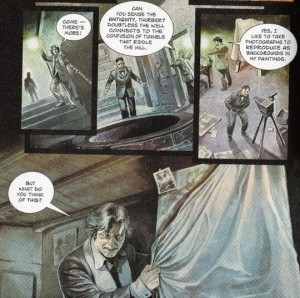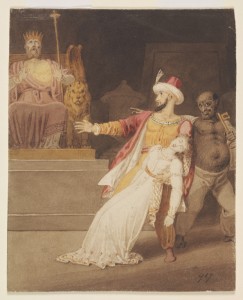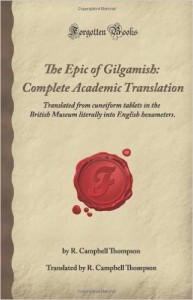“Hampton pointed to the grave, which had been torn open as if by a wild animal of hellish strength. ‘Look,’ he said, ‘The monster itself!’ And there amidst the rotting remains crouched a thing of nightmares, gibbering as it gnawed on a decaying human thigh-bone. I nodded. ‘Very nice. That’s not a proper ghoul, though. You, dear Hampton, have been reading too much Lovecraft.’ I took his arm. ‘Fancy a pint?’ And as we walked away, I thought that perhaps I heard a Meep of disappointment from within the grave.”
Five go Mad in Arkham (J Linseed Grant)

We’re actually here to find the ghul of Middle-Eastern myth, not the dog-headed, corpse-crunching ghoul that it became in the pages of Weird Tales. We’re doing it in two parts, because there’s a lot to work through. Today we’re hunting backwards, from the 1930s to the 1730s (a few years earlier, actually, but it didn’t sound as good).
H P Lovecraft went askew. Or, if you want to put it a nicer way, he drew on the confused works of European translators and earlier authors, and developed his own particular take on the whole concept of the ghoul. So it’s fine, we can still be chums, but how did it all come about?
Nowadays, a ghoulish manner is ascribed to those who have an unhealthy pre-occupation with death and disaster. Those who gather around accidents and car crashes are described as ghoulish. This use of the word ghoul was fairly well established by the start of the 20th century – an unpleasant mentality rather than a creature of horror. Galsworthy, for example, wrote in his 1918 collection Five Tales:
“But then he was such a worthless vagabond, a ghoul who had robbed a dead body.”
Seeking inspiration away from the Gothic vampires and werewolves, Lovecraft developed his own species of ghoul. His story Pickman’s Model (1926) is a good example. In the story, the narrator is introduced to various works by a gifted artist, Richard Upton Pickman. The narrator is fascinated but appalled. Pickman’s art is grotesque, and so, it seems at first, is his imagination.

Listen—can you fancy a squatting circle of nameless dog-like things in a churchyard teaching a small child how to feed like themselves? The price of a changeling, I suppose—you know the old myth about how the weird people leave their spawn in cradles in exchange for the human babes they steal. Pickman was shewing what happens to those stolen babes—how they grow up—and then I began to see a hideous relationship in the faces of the human and non-human figures. He was, in all his gradations of morbidity between the frankly non-human and the degradedly human, establishing a sardonic linkage and evolution. The dog-things were developed from mortals!
These are the ghouls with which most readers of weird fiction are acquainted. Dog-headed creatures who live in groups or packs, and who burrow beneath graveyards, feasting on the remains of the dead. They’re HPL’s ghouls, but they’re not the ghoul or ghul of ancient folklore.
If you want to step closer to the real ghul in fiction of the same period, you can do worse than turn to Henry S Whitehead, one of Lovecraft’s friends. He was one of the few who came close to the true nature of the ghul, in his story The Chadbourne Episode, published seven years after Lovecraft’s Pickman’s Model.
The face was covered with an equal bristle-like growth, unshaven for a month by the appearance. Above the tight-shut, menacing mouth which divided a pair of square, iron-like broad jaws, the facial hairs were merged or blended in what seemed from my viewpoint a kind of vague smear, as though the hair were there heavily matted. From this sinister figure there then emerged a thick gutteral, repressed voice…“Come – come he-ar. Come – I will show you what you look for.”
Whitehead’s ghouls have a Persian origin in the story, and take livestock and children, drawing them close to befuddle and then consume them. This is more promising stuff, but where are Lovecraft and Whitehead getting their basics?
Hanging out in the early twentieth century and wondering about writing a series of blasphemous supernatural tales, writers wanted source material to get the juices flowing. When it came to ghouls, there weren’t many sources.
They might have glanced at archaeologist R Campbell Thompson’s 1903 work The Devils and Evil Spirits of Babylonia, nattily subtitled:
BEING BABYLONIAN AND ASSYRIAN INCANTATIONS AGAINST THE DEMONS. GHOULS, VAMPIRES, HOBGOBLINS, GHOSTS. AND KINDRED EVIL SPIRITS, WHICH ATTACK MANKIND. TRANSLATED FROM THE ORIGINAL CUNEIFORM TEXTS
We say they might (Thompson returns next time), but it’s more likely that they turned to other works. There were passing mentions of ghouls or gouls in literature during the 19th century – a reference to gouls by Byron in 1813; the fact that in Hans Christian Andersen’s tale The Wild Swans (1838), the princess heroine has to get round ghouls chomping on a corpse in a cemetery when trying to save her brothers; a mention by Poe… odds and sods, basically.
Most influential were the various translations of One Thousand and One Nights, or Arabian Nights (kitāb ʾalf layla wa-layla). The first European version of Arabian Nights was a translation by Antoine Galland at the beginning of the 18th century. Galland took his inspiration mainly from an Arabic text from Syria and produced Les Mille et une nuits, contes arabes traduits en français.
Trivia note: Two of the best known stories, “Aladdin’s Lamp” and “Ali Baba and the Forty Thieves” are not from the original Arabic sources. They appeared first in Galland’s translation, and he said he got them directly from an old storyteller.
Unabridged and unexpurgated translations followed in the Victorian period – John Payne’s The Book of the Thousand Nights and One Night (1882), and then Sir Richard Francis Burton’s version (1885) – nicked mostly from Payne but with extra ‘erotica’. Both these were offered by private subscription because of their racy nature (by the standards of the times).
A number of the French and English translations had stories of ghouls, but in many cases the characteristics were exaggerated from the Arabic. For example, the pre-occupation with feasting on corpses dug from graves is most likely an invention of Galland and his successors, made to increase the Eek! Factor for Western audiences. Ahmed K. Al-Rawi, writing in the journal Folklore (2009), goes so far as to say that this idea does not feature in any of the original Arabic sources concerning the ghul.

Writers like Lovecraft, Whitehead and Clark Ashton Smith were all familiar with the Arabian Nights. They would also have known of the classic novel Vathek by William Beckford, from 1786. Beckford, influenced by the Galland translation, wrote Vathek as a piece of Arabian Gothic, cannily hitting two markets at once – the growing Gothic movement and a contemporary fascination with oriental matters.
“Do you then perform the office of a Goul? ‘Tis true you have dug up the dead, yet hope not to make her your prey…”
So everything stems from Galland and his translation. In Part Two, we’ll roll up our sleeves and go into Arabic and Babylonian myth to extract the true ghul, its origins and the reason why seven is a very powerful number…
####
In the meantime, if you want a version of A Thousand and One Nights which captures more of the flavour of the original material, you could do worse than have a look at this, described as “very readable” and “strongly recommended for anyone who wishes to taste the authentic flavour of those tales”. It’s a 1990 translation by Husain Haddawy, based on the 1984 Arabic version of Muhsin Mahdi.
This should have been a mid-week medley, by the way, but we got over-excited and did something else instead. Ghuls are fun, so join us next time…


 arabian nights
arabian nights